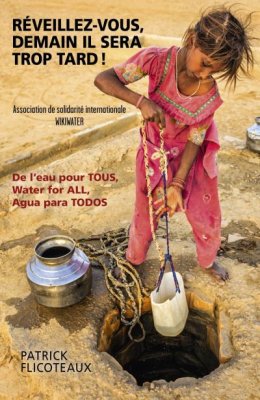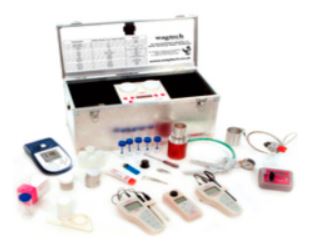
Photo by OIEau
1) What is involved ?
Knowing the criteria required to ensure that water is drinkable.
Drinking water is water that can be drunk with no danger to health as it is not toxic or infested with bacteria, parasites or viruses harmful to humans. More than 4 million people still die each year worldwide due to unsafe water and 885 million do not have access to drinking water. It is therefore important to know the various drinking water quality standards and indicators and to educate those in charge of water management about the importance of water quality control to reduce the number of diseases and mortalities.
2) Who use this means ?
The WHO has defined drinking water quality criteria and recommendations implemented at all times by developed countries and most large towns through the use of continuous analysers or laboratory measurements to ensure that consumers are supplied with drinking water. Although these recommendations are sufficiently stringent, they are not, however, always fully complied with as they are too restrictive for some regions which lack the necessary means to do so. Several regions or countries, such as the European Union, have enacted their own standards.
3) Why ?
Contagious diseases caused by pathogenic bacteria, viruses and parasites are often caused by drinking water not meeting the minimum quality criteria. They are the most common and most widespread health risk. It is therefore important to establish drinking water quality standards and indicators and above all ensure they are complied with, especially at water access points, and if necessary tailor them to areas and local particularities.
4) Who is primarily concerned ?
All populations are concerned by drinking water quality criteria. Poor countries are primarily concerned as only a small proportion of the population is supplied by a public water utility. The remainder of the population draws water directly from its source, in other words, wells, rivers or natural rainfall reserves. These are the populations at the highest risk of drinking contaminated water. Similarly, displaced persons and refugees in camps quickly need drinking water of sufficiently quality not to not cause diseases or even death. Such water is often suspect, however.
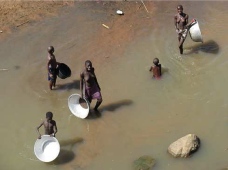 Water must thus meet certain drinking water quality standards before it can be drunk without danger to health :
Water must thus meet certain drinking water quality standards before it can be drunk without danger to health :
- Microbiological drinking water quality : this defines the absence, or presence in sufficiently low amounts, of microorganisms that can cause serious and contagious diseases.
- Chemical drinking water quality : this defines the absence, or presence in sufficiently low amounts, of toxic substances that can cause diseases in the more or less long term.
To be pleasant to drink, water must be clear and not have a bad taste or smell. However, water that does not fully meet these criteria is not necessarily a health risk.
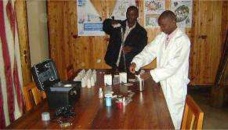
Field laboratory for in-situ analysis for ODAGG - Caritas Ethiopia
5) What do these indicators involve ? How are they used ?
a) Physical and chemical drinking water quality criteria
A list identifying the physical and chemical parameters to be checked and that define drinking water quality and the limit values not to be exceeded, must be drawn up. These parameters determine whether water is drinkable from a chemical and physical standpoint. In addition to the usual parameters, certain specific parameters must be analysed according to the region and the problems encountered. (For example if a region is particularly affected by arsenic being discharged into its water sources, such as Bangladesh, priority should be given to testing for arsenic). Similarly, specific, physico/chemical and bacteriological standards have been established by the WHO for emergency and crisis situations.
Drinking water quality indicators that can be used for this analysis :
- Kits
- Portable sensors
- Strips
- Visual : look at the surface of the water (suspended solids, hydrocarbons, oils, colour and smell)
For this purpose, please refer to the following fact sheet E 27 "Methods and means available for water physical, chemical, and bacteriological analysis".
All this information can be compiled in tabular form with the various parameters to be checked, the amounts not to be exceeded and the results obtained for comparison purposes.
Sample table showing a series of analysable chemical parameters, their measurement units and the limit values not to be exceeded (see WHO 2004)
N.B : For calcium and magnesium (Ca and Mg), these are minimum values 
The following distinctions are made for establishing drinking water quality from a chemical standpoint :
- Undesirable substances : their presence is, however, tolerated as long as they remain below a certain threshold (F-fluoride and nitrates for example).
- Substances having toxic effects : these include lead, chromium, arsenic (Ars) and cadmium (Cd). The tolerated levels are extremely low, sometimes around a millionth of a gram per litre.
b) Bacteriological drinking water quality criteria
A bacteriological list, in other words, a list of the bacteria that should not end up in drinking water or the tolerated limit amount of such organisms in drinking water, should be established.
Microbiological analysis is based on identifying bacteria considered as indicators of fecal contamination : these bacteria were chosen because they are present in large numbers in the faeces of warm-blooded animals that are frequent sources of fairly severe contamination, they are easily detectable and they do not develop in pure water.
- The primary indicator is the presence of Escherichia Coli, or thermotolerant coliforms (bacteria of the same kind as E. Coli) and this indicator is still commonly used. Drinking water must not contain such bacteria. This is a good drinking water quality indicator.
- Other indicators are added, such as the presence of enterococci and Clostridium perfringens spores.
Microbiological drinking water quality standards set by the WHO , provided for reference in a RéFEA fact sheet.
| Parameters | WHO guide values | Interpretation |
| Thermotolerant coliforms | 0/100 ml | Fecal pollution indicators |
| Faecal streptococci | No standards | Fecal pollution indicators |
| Total coliforms |
0/100 ml in 95% of treated water samples |
Treatment effectiveness indicators (disinfection) : do not necessarily report fecal pollution |
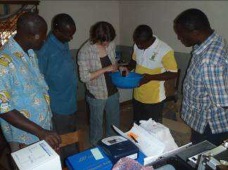 Field analysis laboratory for the main parameters of the water of Ocades-Caritas Togo
Field analysis laboratory for the main parameters of the water of Ocades-Caritas Togo
6) Special difficulties and precautions to be taken, if any
a) Difficulties
- Finding the low-cost indicator or device for measuring these parameters properly.
See the next fact sheet : "Methods and means available for physical, chemical and bacteriological analysis of water"
- Considering the situation of each country or region and focusing on the most important parameters to be analysed to determine whether water is drinkable or not.
- Or tailoring the limit values according to the cases encountered and the country’s sanitary provisions or laws.
b) Precautions to be taken
Several precautions are required during analysis :
- Before sampling : make sure that the river is not polluted downstream of the sampling point, as this would make the samples useless. Also make sure that all containers are clean and uncontaminated and preferably sterilised (chlorine tablets can be used).
- during sampling : adhere to the sampling protocol (properly calibrated probes, significant amounts sampled, etc.), or in vivo analysis methods (temperature measurements, etc.).
After sampling : avoid the sample taken being contaminated : either or by the container or by the appearance of bacteria during storage. Perform the various in situ analysis in accordance with a well-defined experimental protocol.
7) Main advantages and drawbacks
a) Advantages
- Determines the water quality and whether it is acceptable or unfit for human consumption.
- Prevents diseases due to the presence of harmful chemical or biological substances in drinking water.
- Determines the treatments that would be needed, if possible, to make the water safe for drinking.
b) Drawbacks
- Analysis only provides ad hoc information. Analysis only indicates the water quality at the time it is sampled. Such analysis therefore needs to be performed regularly to identify any deterioration in quality.
- The parameters of prime importance may vary according to local conditions.
- Such work only provides information about the water condition. It doe not determine whether the water can be treated or not.
- The analysis of fecal indicators associated with the enumeration of viable bacteria is a sensible, but not quick method. It requires a laboratory equipped to produce bacteriological cultures and trained staff. The minimum time needed to obtain results is 3 days.
- The sampling conditions may play an important role in the results which may be distorted if the sampling and analysis are not performed correctly.
- Water quality may deteriorate in the network or between the source and the point of consumer use. A single measurement at the source may thus not be sufficient if the water is not kept under good conditions. See fact sheet E 15 "Conditions to be complied with for conserving water for family use under good conditions"
8) Achievement example
Eastern Chad provides refuge for 240,000 Sudanese and 180,000 Chadian refugees displaced as a result of ethnic and armed conflicts in Sudan and Chad. These populations had to be relocated in emergency camps where hygiene and sanitation conditions quickly proved to be insufficient and several epidemics such as hepatitis E and diarrhoea broke out between 2004 and 2006.
The WHO is now present in eastern Chad for epidemiological surveillance purposes.
Improved access to safe drinking water and the hygiene and sanitation conditions in the camps through the action of numerous international solidarity associations has contributed to significantly reducing these epidemics
However, some did break out in 2006 as a result of a further influx of displaced Chadians from the border with Sudan and from various areas under attack and who had to be relocated urgently under inadequate hygiene and sanitation conditions.
In 2007, 2,568 cases of hepatitis E and 41 deaths were recorded among displaced persons.
The WHO then decided, with the help of NGOs, to intensify the prevention of these water-borne diseases by establishing a comprehensive drinking water quality control system to minimise risks of faecal-oral diseases being transmitted to displaced persons. In particular, it hired a water, hygiene and sanitation specialist, increased analysis and established protocols for analysis performance, which all helped, together with the other steps taken by the NGOs on the ground, to avoid epidemics.
This is a further compelling argument, despite the urgency of situations, for checking the quality of the drinking water made available to displaced populations as it prevents contamination that could cause diseases and even death and allows prompt, sometimes simple, action to be taken to protect water quality
9) Where to obtain further information - Bibliography
- WHO (World Health Organization). This organisation has published its main Directives (it no longer refers to them as standards) for monitoring and testing water quality in documents that are very specific and detailed, but which are sometimes more useful to specialists or those looking for specific information. These documents can be downloaded as complete documents or chapter by chapter a list of which can be obtained by clicking the following hypertext link which also provides the method to be used :
http[://www.who.int/water_sanitation_health/dwq/gdwq3rev/fr/index.html->http://www.who.int/water_sanitation_health/dwq/gdwq3rev/fr/index.html]
https://www.who.int/countries/fra/fr/
- RéFEA (French-language water-related support centre : This centre has published four useful fact sheets which, while less comprehensive, are much simpler and only a few pages long and which can be obtained (online) by clicking the following hypertext links ;
- Water analysis fact sheet (overview)
http://www.oieau.fr/ReFEA/fiches/An...
- Quality indicator fact sheet
http://www.oieau.fr/ReFEA/fiches/An...
- Bacteriological survey fact sheet
http://www.oieau.fr/ReFEA/fiches/An...
- Physical/chemical analysis fact sheet
http://www.oieau.fr/ReFEA/fiches/An...
- Loughborough University in the UK has published (in English only) an interesting fact sheet on water quality testing methods in emergency situations :
"Field Water Quality Testing in Emergencies" available online at :
https://www.lboro.ac.uk/research/wedc/well/water-supply/ws-factsheets/field-water-quality-testing-in-emergencies/




